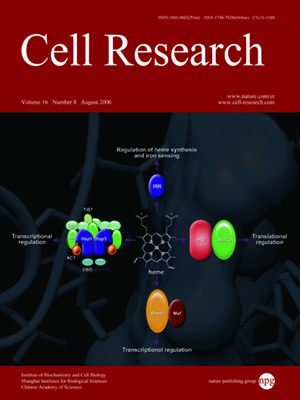
Volume 16, No 8, Aug 2006
ISSN: 1001-0602
EISSN: 1748-7838 2018
impact factor 17.848*
(Clarivate Analytics, 2019)
Volume 16 Issue 8, August 2006: 681-692
REVIEWS
Heme: a versatile signaling molecule controlling the activities of diverse regulators ranging from transcription factors to MAP kinases
Sarah M Mense, Li Zhang
Department of Environmental Health Sciences, Columbia University, Mailman School of Public Health, 60 Haven Avenue, B-106, New York, NY 10032, USA
Correspondence: Li Zhang(lz2115@columbia.edu)
Heme (iron protoporphyrin IX) is an essential molecule for numerous living organisms. Not only does it serve as a prosthetic group in enzymes, it also acts as a signaling molecule that controls diverse molecular and cellular processes ranging from signal transduction to protein complex assembly. Deficient heme synthesis or function impacts the hematopoietic, hepatic and nervous systems in humans. Recent studies have revealed a series of heme-regulated transcription factors and signal transducers including Hap1, a heme-activated transcription factor that mediates the effects of oxygen on gene transcription in the yeast Saccharomyces cerevisiae; Bach1, a transcriptional repressor that is negatively regulated by heme in mammalian cells; IRR, an iron regulatory protein that mediates the iron-dependant regulation of heme synthesis in the bacterium Bradyrhizobium japonicum; and heme-regulated inhibitor, an eucaryotic initiation factor 2a kinase that coordinates protein synthesis with heme availability in reticulocytes. In this review, we summarize the current knowledge about how heme controls the activity of these transcriptional regulators and signal transducers, and discuss diseases associated with defective heme synthesis, degradation and function.
Cell Research (2006) 16:681-692. doi:10.1038/sj.cr.7310086; published online 8 August 2006
FULL TEXT | PDF
Browse 2080


